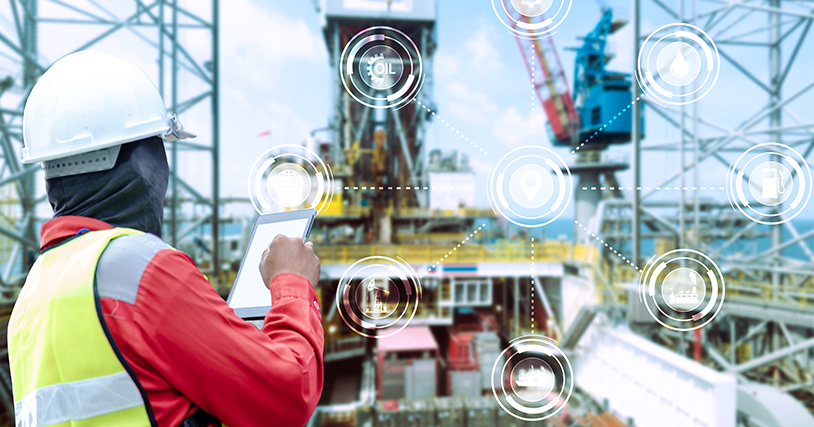
The oil and gas industry operates in challenging environments, from arid deserts to remote wind-swept offshore platforms. As the world’s demand for energy explodes, operators are under increasing pressure to maximize efficiency, minimize risk, and maintain uncompromising safety standards. Like many industries, the sector has begun a significant digital transformation, moving to data-driven decision-making—a revolution fueled by two powerful technologies: Low Earth Orbit (LEO) satellites and the Internet of Things (IoT).
The Road to Data-Driven Oilfields
Equipment failures, leaks, and environmental hazards can escalate quickly, especially when real-time information is unavailable. For decades, oil companies invested heavily in costly work crews conducting manual supervision and interventions just to keep operations running smoothly.
Today, that paradigm is shifting. Modern oilfields are becoming digital ecosystems, where thousands of IoT-enabled sensors and devices work in concert to monitor equipment health, track assets, manage environmental compliance, and ensure worker safety. No longer are Supervisory Control and Data Acquisition (SCADA) sites trickles of data.These connected devices generate vast amounts of data, providing operators with a detailed, real-time view of their operation.
Why Connectivity Matters
At the heart of these digital oilfields is connectivity. Without a reliable network, data from sensors and devices stays within the boundaries of the field itself. For oilfields and pipelines located in remote or harsh environments—far from terrestrial cell towers or fiber networks—connectivity is a significant barrier. Running fiber is often too costly and LTE can have spotty coverage.
Solving this is where LEO satellite connectivity steps in. Although they are space-based, LEO satellites travel close to Earth—less than 1,200 miles above the surface. This low altitude offers the speed, latency, and reliability necessary for digital applications and services.
LEO connectivity ensures that even the most isolated oilfields and pipelines can benefit from always-on, high-bandwidth communications. Thousands of IoT devices—from pressure sensors on pipelines to video cameras monitoring facility perimeters—can transmit critical data in real time to centralized management systems. The result is a truly connected oilfield, anywhere.
Smarter Asset Management
One of the most significant advantages of combining LEO connectivity with IoT devices is more innovative asset management. Oilfields and pipelines rely on a vast array of critical infrastructure assets: pumps, compressors, valves, drilling rigs, and vehicles. IoT sensors installed on these assets continuously monitor parameters such as temperature, vibration, pressure, and flow rate.
With robust connectivity, this data is no longer inaccessible and sitting idle at a remote location—there is now real-time analysis. Predictive maintenance algorithms can spot early signs of wear or malfunction, triggering alerts before a failure occurs. This shift from reactive to proactive maintenance reduces downtime, extends asset life cycles, and lowers operational costs. More and more oil and gas companies are deploying AI-tools to analyze this new IoT unlocked data to enhance operational efficiency.
For example, imagine a remote wellhead equipped with vibration and pressure sensors. If the sensors detect readings outside normal parameters, an alert is sent instantly via LEO satellite to the operations center. Maintenance teams, or even a remote drone, can be dispatched to access the situation and deploy the right tools and parts, avoiding unnecessary trips and costly delays.
Enhancing Safety in Isolated Locations
Safety and compliance are cornerstones of any oilfield operation, and real-time monitoring is critical in environments where risk is ever-present. IoT devices play a vital role in protecting workers and the environment by providing early warnings of hazardous conditions.
Gas leak detectors, fire alarms, and environmental sensors can immediately alert teams to dangerous situations. Wearable devices monitor the location and health of personnel (man down applications), ensuring that help can be dispatched quickly in an emergency. With LEO connectivity, these alerts are transmitted instantly, even from the remotest corners of the oilfield.
Moreover, video surveillance cameras connected via satellite networks can provide live feeds to teams hundreds or thousands of kilometers away. Deterring unauthorized access and enabling rapid response in case of accidents or security breaches.
Environmental Stewardship and Compliance
As regulatory scrutiny intensifies, oil and gas companies must demonstrate a commitment to environmental stewardship or get shut down. IoT sensors help operators monitor emissions, water quality, and soil conditions, ensuring compliance with local and international standards.
LEO-enabled connectivity means that environmental data is uploaded continuously to reporting systems, providing an auditable trail and enabling prompt action. In addition, historical data analysis allows companies to identify trends and risks, supporting more sustainable operations.
The Future: A More Resilient, Efficient Oilfield
The integration of LEO satellite connectivity and IoT technologies is setting the stage for a new era in oil and gas production. Oilfields are becoming smarter, safer, and more efficient—able to operate in the most challenging environments while minimizing risk and maximizing productivity.
As the sector continues its industrial digital transformation, investments in connectivity and IoT will pay dividends in operational excellence, safety performance, and environmental responsibility. The oilfield of tomorrow will be agile, data-driven, and resilient—a testament to the power of innovation at the intersection of space and sensor technology. Learn how.